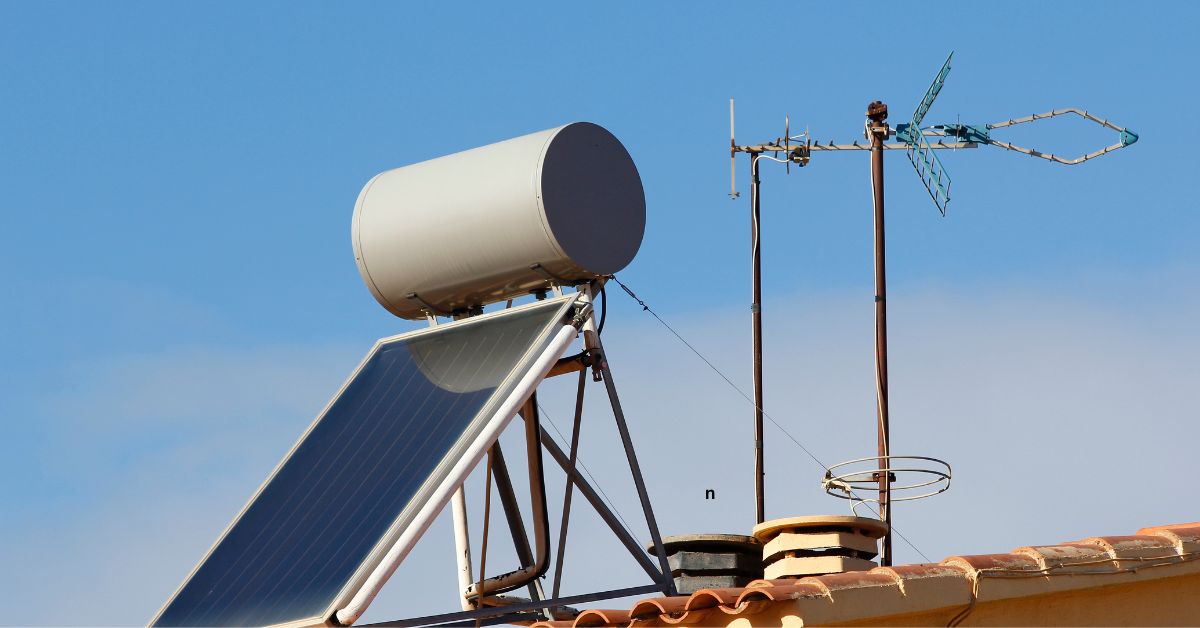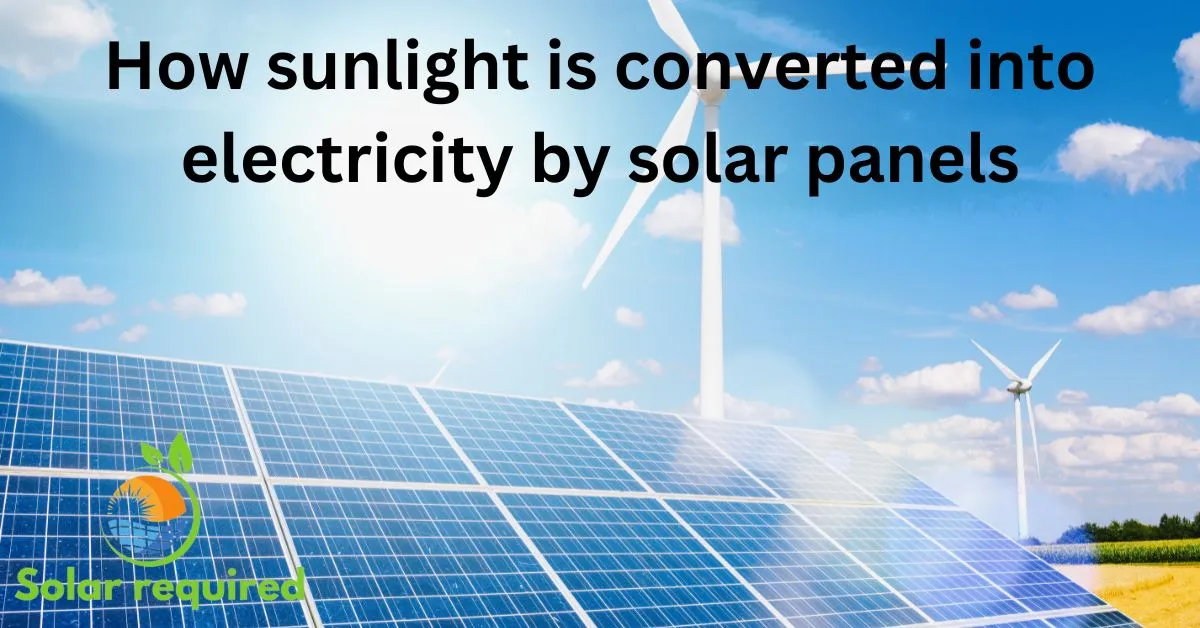In today’s world, we need more sustainable energy. Solar thermal panels are a big step forward. They use the sun’s power to heat homes and businesses.
This means we use less of the old energy sources. It helps make our future greener. Learning about solar thermal panels can help you live more sustainably.
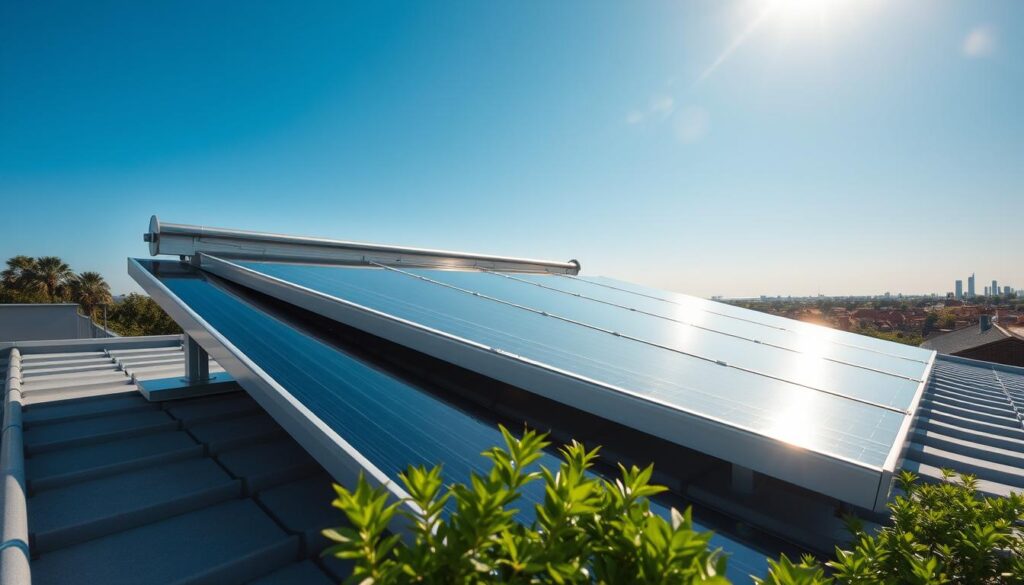
Key Takeaways
- Solar thermal panels convert sunlight into thermal energy, providing an efficient heating solution.
- They offer a sustainable alternative to traditional heating systems, reducing your carbon footprint.
- Solar thermal technology is versatile and applicable to a wide range of residential and commercial applications.
- Investing in solar thermal panels can lead to significant long-term cost savings on your energy bills.
- Government incentives and rebates are often available to encourage the adoption of solar thermal technology.
Foldable Solar Panel: What you need to know
Understanding Solar Thermal Panel Technology
The tech behind solar thermal panels is cool and works well. It uses the sun’s energy to heat water and air. This tech has parts that work together to catch and keep the sun’s heat.
Basic Principles of Solar Energy Collection
Solar thermal panels catch the sun’s rays and turn them into heat. They use dark surfaces to soak up the sun. Then, they pass the heat to a fluid, like water, to move it around.
How Solar Thermal Systems Convert Sunlight to Heat
The heated fluid goes to a tank or heat exchanger. There, it can be used for solar heating or solar water heaters. How well it does this is key to its success.
Key Components and Their Functions
- Solar Collectors: The main part, is catching the sun’s rays and making heat.
- Heat Transfer Fluid: Carries the heat from the solar collectors to where it’s needed.
- Thermal Energy Storage: Holds the heat for later use, not just when the sun is out.
- Distribution System: The pipes and controls that get the heat to where it’s needed.
Knowing how solar thermal tech works helps people choose it for a greener future.
Types of Solar Collectors: Making the Right Choice
Choosing the right solar collector is key to getting the most from the sun. Each type has its strengths and weaknesses. Let’s look at the main types and what makes them special.
Flat Plate Collectors
Flat plate collectors are the most common. They have a dark surface that turns sunlight into heat. This heat is moved to a fluid that goes through the system.
They are reliable and not too expensive. This makes them great for homes and businesses.
Evacuated Tube Collectors
Evacuated tube collectors are more efficient than flat plates. They have glass tubes with absorber plates inside. The space between the tubes is empty, which helps keep heat in.
They work best in cold places and for hot water needs. This is because they can get hotter than other types.
Concentrating Solar Power (CSP)
Concentrating solar power systems use mirrors or lenses. They focus the sun’s rays onto a small, efficient collector. This creates very hot steam or fluids.
They are big and used for power plants. But, they can also be used in smaller systems.
Parabolic Trough Collectors
Parabolic trough collectors use mirrors to focus sunlight. The heat is then used to make steam or hot water. They are very efficient and used in big solar plants.
| Solar Collector Type | Efficiency | Cost | Best Applications |
|---|---|---|---|
| Flat Plate Collectors | 40-60% | $ | Residential, commercial, and small-scale applications |
| Evacuated Tube Collectors | 50-70% | $$ | Colder climates, higher-temperature heat applications |
| Concentrating Solar Power (CSP) | 15-30% | $$$ | Large-scale, utility-grade solar power plants |
| Parabolic Trough Collectors | 20-30% | $$$ | Large-scale solar power plants |
When picking a solar collector, think about efficiency, cost, and what you need. Knowing the good and bad of each type helps you choose wisely.
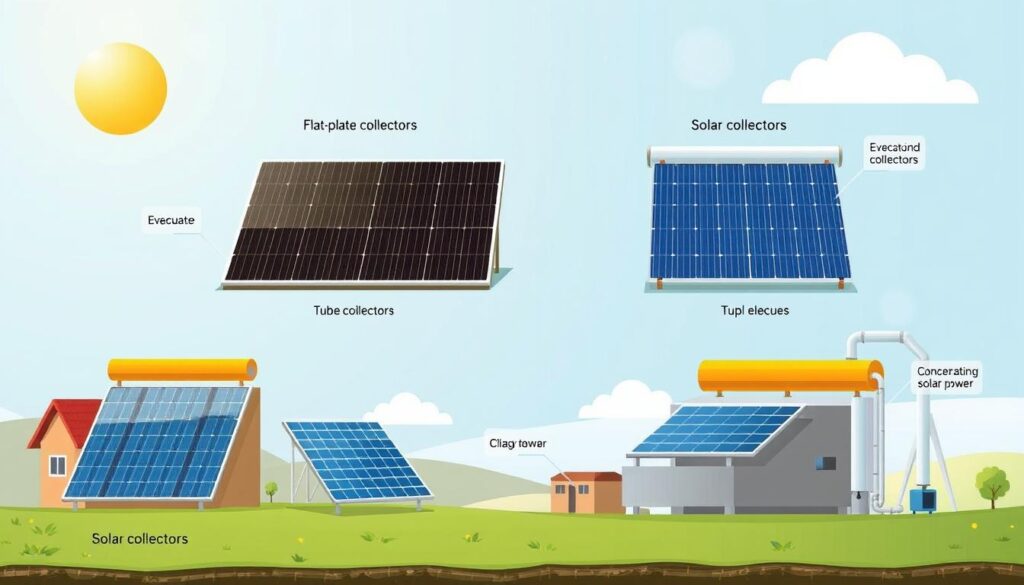
Benefits of Installing Solar Thermal Panels
Getting a solar thermal system has many perks. It’s good for the planet and saves you money. It’s a green way to heat your home, making it more energy-efficient and reducing carbon emissions.
Environmental Impact and Sustainability
Solar thermal panels use the sun’s power to make clean heat. This makes them a top choice for energy-efficient and sustainable heating. They help cut down on harmful emissions, making our future greener.
Cost Savings and ROI Analysis
While solar thermal systems cost more upfront, they save you money in the long run. They cut down on bills by using less non-renewable energy. This makes your investment pay off over time.
Government Incentives and Rebates
Many governments give incentives and rebates for energy-efficient and sustainable heating like solar thermal panels. These help lower the cost of getting started. They make it easier for more people to go green.
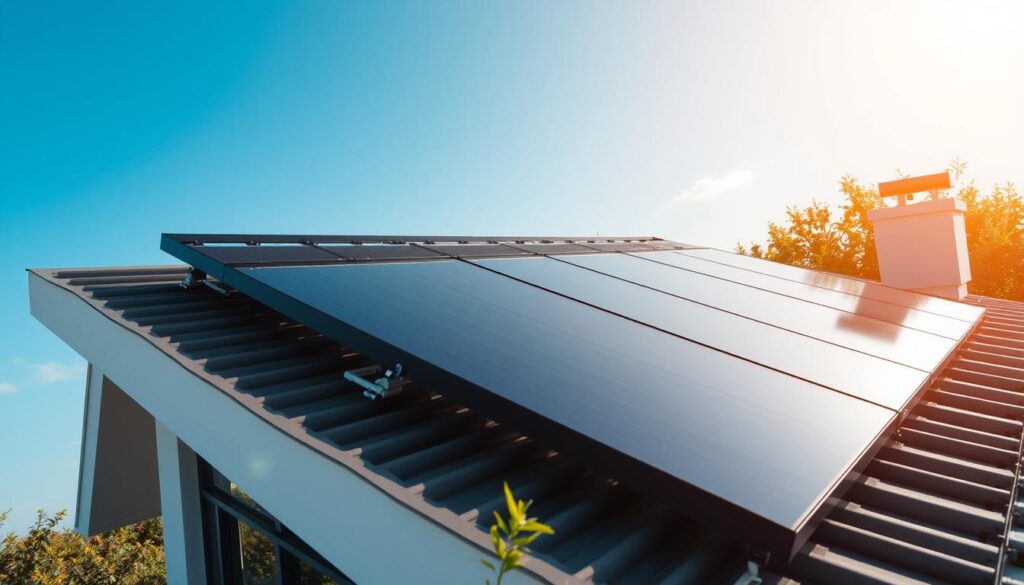
“Transitioning to a solar thermal system is a smart investment that not only benefits the environment but also your wallet in the long run.”
Check: Solar Panels New Jersey 2025 Updates
Solar Thermal Panel Installation Process
Thinking about getting a solar thermal panel system? The installation process is key to know. It involves site assessment to system integration. This step is crucial for the system’s performance and reliability over time.
Let’s explore the main steps in the solar thermal panel installation process:
- Site Assessment: A pro will check your property. They look at roof orientation, shading, and space to find the best spot for panels.
- System Design: After assessing the site, the installer designs a system that fits your energy needs and home.
- Permits and Approvals: You might need permits from local authorities. Your installer will take care of this.
- System Installation: Experienced techs will install the panels, tanks, and other parts. They ensure a safe and professional job.
- Integration with Existing Systems: The new system will work with your home’s plumbing and heating. This makes the switch to renewable energy smooth.
- Inspection and Activation: After installation, the system is checked and tested. Then, it’s activated for use.
Want to install it yourself? DIY solar thermal panel installation is possible. But, make sure to research well, get the right permits, and follow safety rules for a successful installation.
Whether you go for a pro or DIY, installing solar thermal panels is a big step. It lets you use the sun’s power for heating and water.
| Key Factors for Successful Solar Thermal Panel Installation | DIY Installation | Professional Installation |
|---|---|---|
| Site Assessment | Requires thorough research and evaluation | Expertly conducted by trained professionals |
| System Design | Requires technical knowledge and planning | Customized to your home’s unique needs |
| Permits and Approvals | Homeowner responsibility to obtain | Handled by the installation company |
| Installation Quality | Requires significant time and effort | Performed by experienced technicians |
| System Integration | Can be challenging for DIY enthusiasts | Seamlessly integrated with existing systems |
The solar thermal panel installation process is vital for using the sun’s power. Whether you choose a pro or DIY, plan and execute well. This ensures the system works well for a long time.
Maintenance and Care for Your Solar Thermal System
Keeping your solar thermal system in good shape is key. Regular maintenance and fixing common problems help a lot. This way, you get the most out of your solar thermal system and use more thermal energy. This boosts your energy efficiency too.
Regular Maintenance Schedule
For your solar thermal system to work well, follow a set maintenance plan. This plan includes:
- Regularly clean the solar panels and collectors to remove dirt
- Check and refill the fluid as needed
- Make sure the pump and other parts work right
- Check the insulation and seals to keep heat in
- Look for any damage to the electrical parts
Common Issues and Troubleshooting
Solar thermal systems are mostly reliable, but you might face some issues. These can be:
- Less performance because of shadows or blocks
- Fluid leaks or freezing in cold weather
- Broken parts like the pump or control system
- The solar collector’s coating wears off over time
Knowing these problems and how to fix them can help a lot. You might not need a pro for these fixes.
Professional Service Guidelines
While you can do some maintenance yourself, get a pro to check your solar thermal system now and then. They can do a full check, find hidden problems, and fix or update things. This ensures you get the best thermal energy and energy efficiency.
Comparing Solar Thermal vs. Other Heating Solutions
Homeowners and businesses are looking for ways to reduce energy costs and help the planet. Solar thermal technology is a big hit because it uses the sun’s power for heating. Let’s look at how it stacks up against other heating methods.
Traditional Heating Methods vs. Solar Thermal
Many homes use gas or oil furnaces for heat. But these methods use up fossil fuels, harming the environment. Solar heating systems, however, use solar energy to heat homes. This makes them a greener and more energy-efficient choice.
Renewable Energy Alternatives
Heat pumps and geothermal systems are also good for the planet. Yet, they might need more setup and aren’t for every place. Solar thermal systems, though, fit well with most homes, making them easier to use.
| Heating Solution | Efficiency | Upfront Cost | Environmental Impact |
|---|---|---|---|
| Gas/Oil Furnace | 80-95% | $3,000 – $6,000 | High carbon emissions |
| Heat Pump | 300-400% | $4,000 – $7,000 | Moderate emissions, depending on energy source |
| Geothermal System | 300-600% | $10,000 – $30,000 | Low emissions, highly efficient |
| Solar Thermal | 50-80% | $6,000 – $15,000 | Zero emissions, renewable energy |
The table shows solar thermal systems are a great mix of efficiency, cost, and green benefits. They’re a top pick for those wanting to lower their carbon footprint and save money.
“Solar thermal technology is a game-changer in the world of home heating, offering a clean, renewable, and cost-effective solution that can benefit both the environment and homeowners’ wallets.”
Choosing between solar thermal and other heating options depends on what you need, your budget, and what you prefer. By looking at all your options, you can pick the best fit for your energy and environmental goals.
Integrating Solar Thermal Panels with Existing Systems
Solar thermal technology is great for adding renewable energy to your home. It works well with your current heating and cooling systems. This way, you can use less energy and help the planet.
Compatibility with Home Heating Systems
Solar thermal panels fit with many home heating systems. This includes forced-air furnaces, hot water systems, and radiant floor heating. Make sure the solar system matches your home’s setup. You might need to update some parts, but it’s worth it for the savings and green benefits.
Storage Solutions and Backup Options
Solar thermal tech is good at storing thermal energy for later use. Systems like insulated tanks or phase-change materials help. They save heat for when it’s cloudy or nighttime. Plus, many systems have backup heat to keep your home comfy.
Smart Control Integration
Adding solar panels to smart home tech makes things better. Solar air conditioning and smart controls adjust your system as needed. This saves energy and boosts the use of solar thermal electricity.
By linking solar panels with your home systems, you get the best of both. Enjoy your current comfort and save money and the planet with solar energy.
Real-World Applications and Case Studies
Solar thermal panels are making a big difference in homes and businesses. They save a lot of energy and help us use green heating. Here are some examples of how well they work.
The Jones family in California put a solar thermal system on their roof. It replaced their old gas furnace. They saved 30% on their heating bills in the first year. This saving has kept growing.
The system also cuts down on carbon emissions. This helps the Jones family live more sustainably.
The Acme Corporation in the city installed a solar thermal system in their new office. It uses the sun’s energy for heating and hot water. This cuts their energy use and pollution.
This move made Acme a leader in green technology. It also made them known as a company that cares about the planet.
FAQ
What is a solar thermal panel?
A solar thermal panel, also known as a solar collector, captures the sun’s energy. It turns this energy into heat. This heat can be used for heating water, warming spaces, or making electricity.
How do solar thermal panels work?
Solar thermal panels use special materials to collect and transfer the sun’s energy. They have a dark-colored plate and a clear cover. When sunlight hits the plate, it heats up and transfers this heat to a fluid. This fluid is then used for heating or other needs.
What are the different types of solar thermal collectors?
There are several types of solar thermal collectors: – Flat-plate collectors are common. They have an absorber plate in an insulated box with a clear cover. – Evacuated tube collectors use tubes with a vacuum. This makes them more efficient than flat-plate collectors. – Concentrating collectors use mirrors or lenses. They focus sunlight on a small area, reaching higher temperatures.
What are the benefits of installing solar thermal panels?
Solar thermal panels offer many benefits: – They lower your energy costs and utility bills. – They reduce your environmental impact and carbon footprint. – They increase your energy efficiency and self-sufficiency. – You might get government incentives, rebates, and tax credits. – They operate quietly and require little maintenance.
How do I maintain and care for my solar thermal system?
Keeping your solar thermal system in good shape is key. Here’s how: – Clean the collectors regularly to remove debris. – Check and top up the fluid levels. – Drain and flush the system to prevent buildup. – Have a qualified technician inspect and tune up the system annually. – Watch the system’s performance and fix any problems quickly.
How does a solar thermal system integrate with my existing home heating and cooling systems?
Solar thermal systems work well with your home’s heating and cooling systems. They can be the main heat source, with your system as a backup. They can also work with thermal energy storage solutions for heating and cooling when it’s not sunny.
What are some real-world examples of successful solar thermal installations?
Many buildings have successfully used solar thermal technology: – A community center in California cut their energy costs by 50% with a solar thermal system. – A hotel in Hawaii reduced their energy bills by 30% with evacuated tube collectors. – A university in New York uses a solar thermal system to meet a big part of their heating needs.
